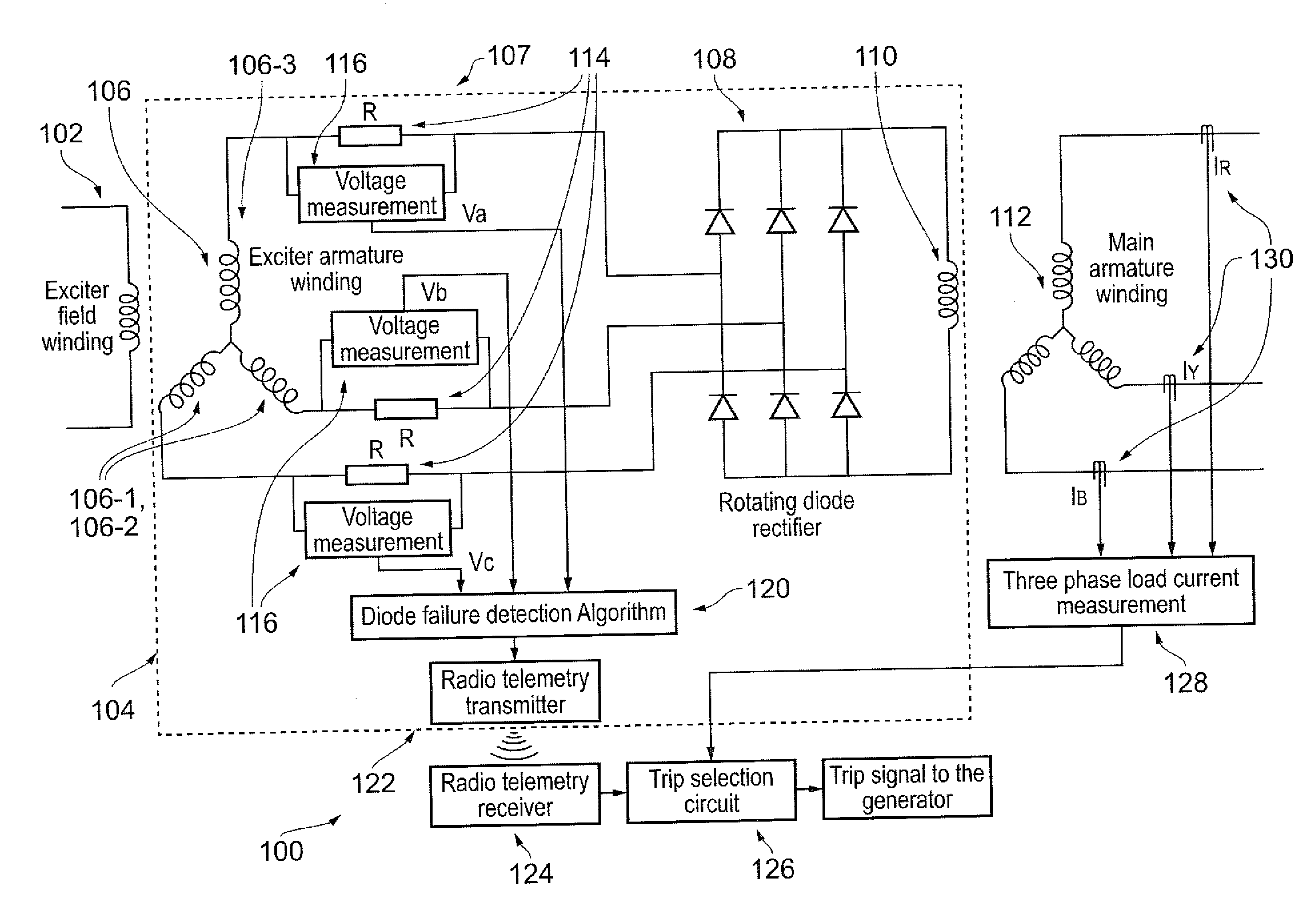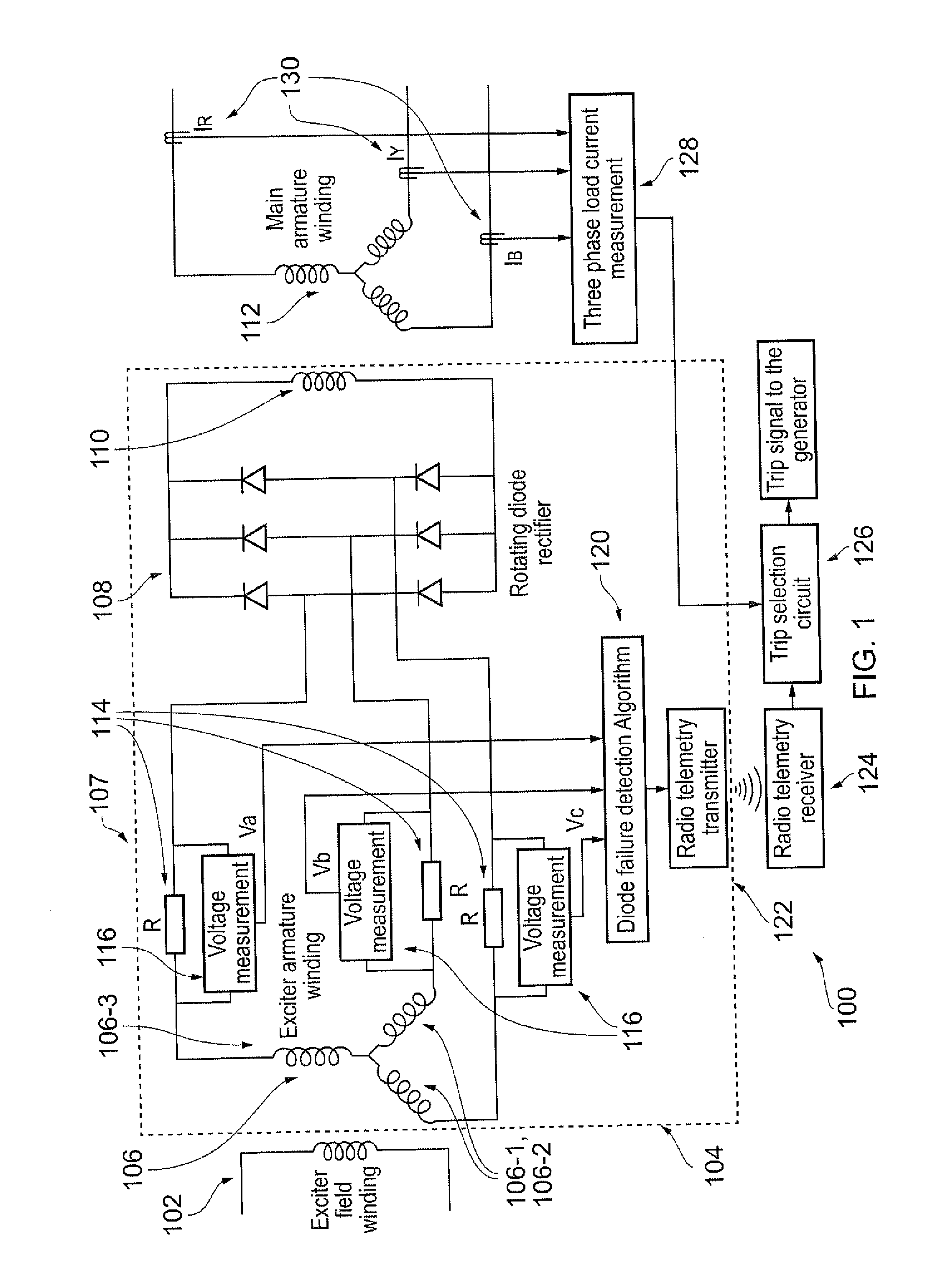Fault detection in brushless exciters
a brushless exciter and fault detection technology, applied in the direction of electric generator control, dynamo-electric converter control, instruments, etc., can solve the problems of increasing the stress on other devices, short circuit, direct fault detection in the rotating rectifier of ac brushless exciter becomes very difficult, etc., to achieve linear but balanced behaviour, high imbalance effect, and rapid rotating diode fault detection respons
- Summary
- Abstract
- Description
- Claims
- Application Information
AI Technical Summary
Benefits of technology
Problems solved by technology
Method used
Image
Examples
first embodiment
[0094]FIG. 1 shows the present invention applied to a brushless synchronous generator 100, as described above.
[0095]A respective small resistor 114 is connected in series with each armature (phase) of exciter armature winding, as shown. The measured voltage drop across each resistor, e.g. measured by respective voltage sensors 116, is used to derive an exciter fault (failure) indication signal based upon the algorithm / methodology proposed herein. In particular, the exciter fault (failure) may be a rotating diode fault (failure).
[0096]In embodiments, the acquired data (the measured voltage drops) are processed according to the proposed algorithm / methodology, e.g. by a processor 120, and a final control signal is optionally transferred to the stator through a rotating radio telemetry transmitter 122 in order to control the operation of the generator.
[0097]For example, a stationary receiver 124 can optionally be used to collect the control signal from the rotor transmitter. The receive...
third embodiment
[0127]In this third embodiment, in order to detect the fault, e.g. the open or short circuit diode fault, the currents (Ia, Ib and Ic) in the respective exciter armatures 106-1, 106-2 and 106-3 are analysed with reference to a threshold value.
[0128]So, for example, S301 may be similar to S201. However in S302, the armature currents Ia, Ib and Ic are calculated, for example using the following equations: Ia=Va / R, Ib=Vb / R and Ic=Vc / R.
[0129]In S303 harmonic analysis of the armature currents is performed, for example as discussed below in more detail.
[0130]In S304 the result of the harmonic analysis is compared with a (predefined) threshold value, similarly to that described for S203 above to establish whether or not a fault has occurred.
[0131]In the event that a determination is made that the result of S303 does not exceed the (predefined) threshold, then in S305 a judgement may be made that there is no fault in the exciter circuit 107; specifically that there is no fault in a rotating...
fourth embodiment
[0137]FIG. 8 shows the present invention, in which respective current sensors 132 are arranged to measure the current flowing in each armature.
[0138]Through harmonic analysis (similar to that of the third embodiment and as described below) of the measured exciter armature currents, the open circuit or short circuit diode fault can be detected.
[0139]An example of the harmonic analysis will be discussed below in more detail.
[0140]In a fifth embodiment, three voltage sensors 116 are used to measure the respective voltages of each exciter armature 106-1, 106-2 and 106-3, similarly to the second embodiment. Two self-powered current sensors 132 are also used to measure the line currents of two of three exciter armatures, e.g. as shown in FIG. 9. Current sensors 132 may be similar to those shown in FIG. 8 for example.
[0141]Computational unit 120 (equivalent to processor 120) is provided to perform the algorithm / methodology for determining whether or not exciter circuit 108, specifically re...
PUM
 Login to View More
Login to View More Abstract
Description
Claims
Application Information
 Login to View More
Login to View More - R&D
- Intellectual Property
- Life Sciences
- Materials
- Tech Scout
- Unparalleled Data Quality
- Higher Quality Content
- 60% Fewer Hallucinations
Browse by: Latest US Patents, China's latest patents, Technical Efficacy Thesaurus, Application Domain, Technology Topic, Popular Technical Reports.
© 2025 PatSnap. All rights reserved.Legal|Privacy policy|Modern Slavery Act Transparency Statement|Sitemap|About US| Contact US: help@patsnap.com



